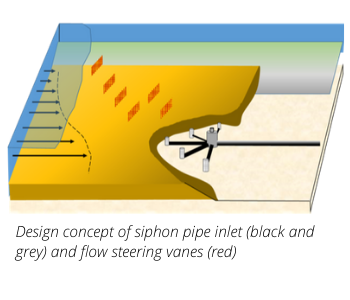SAFL awarded funding to design more environmentally-friendly hydropower technologies

The St. Anthony Falls Laboratory at the University of Minnesota was recently selected for funding by the U.S. Department of Energy (DOE) to design and develop a modular dam technology that could help lift barriers to development of new hydropower projects across the nation.
Hydropower, or the ability to generate electricity from water, is an important renewable energy with a low lifetime carbon emission footprint. Most hydropower to date has been realized through the use of hydroelectric dams, which although they can generate reliable energy, can have negative impacts on the surrounding environment. One of these impacts includes interrupting the movement of sediment (sand, gravel, and silt, etc.) from upstream to downstream, which can not only compromise downstream aquatic habitat and channel shape and structure, but also lead to costly maintenance issues and reduced turbine performance from sediment deposition in the upstream reservoir.
SAFL’s team, including project partners Barr Engineering Company, Utah State University, and Voigt Consultants, LLC, was awarded the project to design and develop a module sediment passage technology for sand-bed river systems and new dams up to 30 feet high. The module relies on an approach defined as ‘hydrosuction,’ which uses siphon flow to continually pass sediment through a dam structure. As sediment approaches the dam, submerged grids will direct flow and sediment to siphon inlets and into a pipe (see figure at right). The pipe will terminate downstream of the dam, with the water elevation drop across the dam providing the energy needed to continually move flow and sediment through the pipe without the need of pumps.
The team will utilize SAFL’s Main Channel facility to test and prototype the module design through experiments, supported also by computational fluid dynamics (CFD) modeling. SAFL will also partner with Oak Ridge National Laboratory to assimilate their knowledge and expertise in advanced fabrication and manufacturing into the design. The outcome of the project will result in a sediment transport module that can integrate with the DOE’s Standard Modular Hydropower platform (SMH), which focuses on generating electrical energy at dams while also providing protection of important river connectivity and environmental functions.
“Advancement of this technology will help address a major barrier facing new hydropower project development in the U.S.” says Jeffrey Marr, lead PI and SAFL’s Associate Director of Facilities and Engineering. “A sediment passage module will not only improve performance of hydropower facilities, but also will help reduce impacts downstream of the dam, promoting healthier aquatic ecosystems and river function.”
The project is a 2-year effort. The SAFL team includes Jeffrey Marr, SAFL Associate Director of Facilities and Engineering; Michele Guala, SAFL Associate Director of Research and Associate Professor in the Department of Civil, Environmental, and Geo- Engineering; John Gulliver, Professor in the Department of Civil, Environmental, and Geo- Engineering, and Lian Shen, SAFL Director and Professor in the Department of Mechanical Engineering.
To learn more about the DOE’s hydropower vision and current funding effort regarding hydropower technologies, see this linked press release.
Contact: Barbara Heitkamp, bkb0811@umn.edu
